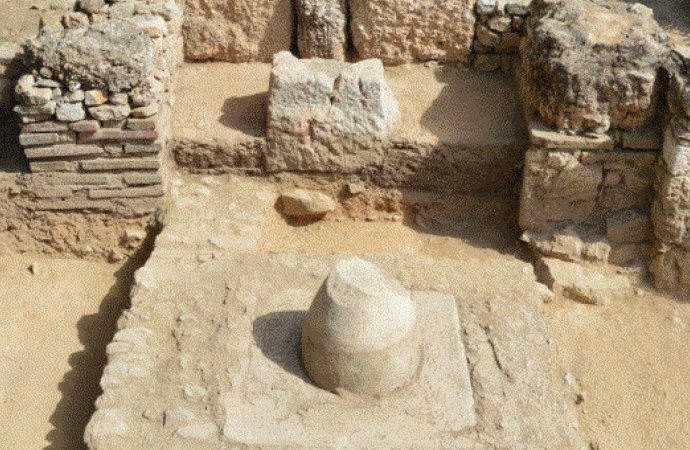The well dates back 1800 years but the prophecy at the sanctuary was evidently much older, archaeologist says.
An oracle well at least 1800 years old dedicated to the god Apollo has been discovered in Athens.
Though the powers of the oracle at Delphi and others were famously plied by the ancient Greeks, this is the first ancient oracular edifice to Apollo to have been found in Athens itself, Dr. Jutta Stroszeck, director of the Kerameikos excavation on behalf of the German Archaeological Institute at Athens, told Haaretz. The well would have been used for hydromancy, a method of divination by means of water.
The ancients routinely sought oracular guidance not only on the future, for simple everyday matters, such as finding/keeping a lover, ahead of a journey, after falling ill, and so forth – or applying for asylum in the sanctuary.
The excavators also investigated a 2500-year-old bathhouse that served travelers and the people of Athens alike that was found in the current excavation season.
Kerameikos is smack in central Athens, just northwest of the Acropolis. That ancient gateway to the city marked the neighborhood of the potters. The whole area is lavishly watered by the Eridanos River, which flows through the city from east to west.
The Athenians built wells along the course of this river, some of them for public use.
“Water, and in particular drinking water, was sacred,” Stroszeck says. “In Greek religion, it was protected by nymphs, who could become very mischievous when their water was treated badly.”
To appease these emotionally precarious godlets, offerings such as miniature vessels containing liquids and other gifts were dedicated in the water.
Holy water, nymph style
The ancient Athenian neighborhood of Kerameikos (in Latin, Ceramicus) has been undergoing excavation since the 19th century, which is when a large sanctuary some 600 square meters in area, featuring a marble omphalos was brought to light.
An omphalos is a conical stone representing the navel of the world, where Zeus initiated the creation of the cosmos.
The most famous omphalos was located in Delphi, believed by the Greeks to be the center of the world. (According to legend, Zeus sent off two eagles to find the middle of the world, and they collided at Delphi. The god then threw a stone from the sky that also fell into Delphi – and that is the stone still visible today at the Delphi shrine.)
The Athenian omphalos lay between an altar and the base of a cult image in the center of a rectangular enclosure.
Cleaning by the excavators in 2012 revealed that the omphalos had been meticulously mounted on a marble slab that, in turn, covered an opening. This prompted further investigation.
The omphalos was lifted carefully using a crane. Under it the archaeologists found a circular well.
The well was walled with clay cylinders and featured more than twenty inscriptions in Greek, all repeating the same phrase: “Come to me, O Paean, and bring with you the true oracle”. The term “Paean” is one of the epithets that designated the Olympian god Apollo, son of Zeus and the god associated with ritual purification, oracular activity (and the arts).
Mysteries and sacred rites
The neighborhood of Kerameikos included the ancient Athenian potters quarter (Demos Kerameon), including the monuments bordering its main street, which connected the ancient agora (marketplace) with the area of Plato’s Academy. The area also contained an ancient cemetery featuring funerary monuments that had been erected along the processional road to Eleusis, where the mysteries were celebrated every year.
This whole area was characterized by transition: from civic to rural areas, and from the city of the living to the place of the dead.
“In such areas, the presence of divine and the supernatural were experienced intensively, which is why cult and mantic activities are dense in such areas,” Stroszeck told Haaretz, adding that a fragment of a prayer common to the participants in the Eleusinian cult was found in a well right by the oracle well.
The many shrines discovered in Kerameikos show that it was an important center for cultic activity.
For instance, the oracle to Apollo was found inside in a sanctuary where Artemis Soteira (‘She who saves’) and Apollon Paian (‘He who helps’) were venerated. Other gods protected public order, justice, children and the personal health of their worshippers.
The excavations have also investigated the wells and water supply of a bathhouse about 60 meters outside the city-gate on the road to the Academy – which has to be the spa mentioned by the Greek rhetorician Isaios, and referred to by Aristophanes.
It was a public, not a private bathhouse, and it existed from the Classical to the Hellenistic times (5th-3rd century BCE). The place was frequented by travellers, Athenians (for example teenage boys undergoing formal education, the ephebs), craftsmen – such as potters, and by the prostitutes gathering in the area around the city gates.
Source: Haaretz

































Leave a Comment
You must be logged in to post a comment.